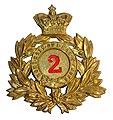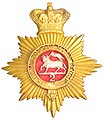Badges of
The Queen’s Royal Regiment (West Surrey)

Carlisle Figure 1715
 |
 |
 |
| Regimental Grenadier Mitre Cap 1760 |
Other Rank's Shako Plate 1861-69 |
Other Rank's Shako Plate 1869-78 |
Upon the front flap of their mitre caps is displayed the lamb device, but without halo or flag; indeed, the addition of these features probably occurred as late as the early 19th century. The 1768 Clothing Warrant, while mentioning the use of the "ancient badge" of the lamb on the three corners of the Regimental Colour, specified that the badge on the grenadier caps should be the King's crest, cypher and crown, and an engraving which appears to depict the lamb upon the plate of 1768 grenadier cap may perhaps have been confused with the antelope badge of the 6th Foot.
However, the Paschal Lamb was definitely carried upon the officers' plate of the 1816 "Regency" shako, the central disc of which bore a silver Paschal Lamb and sphinx below scrolls inscribed "Peninsula" and with the old regimental motto, "Pristinae Virtutis Memor"; with the inscription "The Queen's Royals" at the base. The officers' shoulder belt plate from about 1830 displayed the Paschal Lamb on the ground on blue enamel, surrounded by a pierced, enamel-backed strap inscribed "Pristinae Virtutis Memor" (the backing to the strap also recorded in red enamel), and a similar central design was carried on the officers' plate of the succeeding 1829 shako, for which two designs are recorded.
 |
 |
 |
 |
| Officers Shoulder Belt Badge 1833 |
Other Rank's Cross Belt Badge 1824-33 |
Officers Shako Plate 1861-69 |
Officers Shako 1861-69 |
The first consisted of an eight-pointed gilt star with a crown covering the upper point, upon which was affixed a silver diamond-cut star bearing battle-honours on the longest side "rays", at the right from top to bottom, "Vittoria" over "Nivelle" over "Peninsula", and at the left, "Salamanca" over "Pyrenees" over "Toulouse". In the centre was the lamb over "2" within the strap as on the belt plate, with a sphinx upon a tablet inscribe "Egypt", backed by a laurel wreath, between the top of the strap and the base on the crown. The honours "Vimiera" and "Corunna" were awarded in June 1833, necessitating an alteration in the shako plate: the second pattern had a similar back-plate, silver diamond-cut star and central device, but with the honours removed from the rays of the star and carried instead on scrolls intertwined among a large laurel wreath which surrounded the central strap: on the right, "Vimiera", "Salamanca", "Pyrenees" and "Toulouse", and on the left "Corunna", "Vittoria", "Nivelle" and "Peninsula".
 |
 |
 |
 |
| Officers Helmet Plate 1878-81 |
Other Rank's Gengarry Badge 1874-81 |
Officers Helmet Plate 1881-1902 |
Other Rank's Blue Cloth Helmet 1881-1902 |
Three new honours were authorised in July 1840, and appeared on the officers' plate of the 1844 (Albert) shako. The usual crowned-star plate bore a wreath of palm (right) and laurel (left) upon which were the new honours, "Khelat" (right) and "Ghuznee" (left), and below them the previous honours, "Salamanca", "Pyrenees" and "Nivelle" (right), "Vimiera", "Corunna" and "Vittoria" (left), with "Toulouse" at the base. Within the wreath was a circlet bearing "Pristinae Virtutis Memor", enclosing "2"; below was the new honour "Afghanistan" on a scroll, and below that the Paschal Lamb: above the wreath was a sphinx above a scroll inscribed "Peninsula". The general pattern plates of the other ranks were distinguished only by the regimental number.
« Previous ![]() Back to List
Back to List ![]() Next »
Next »
